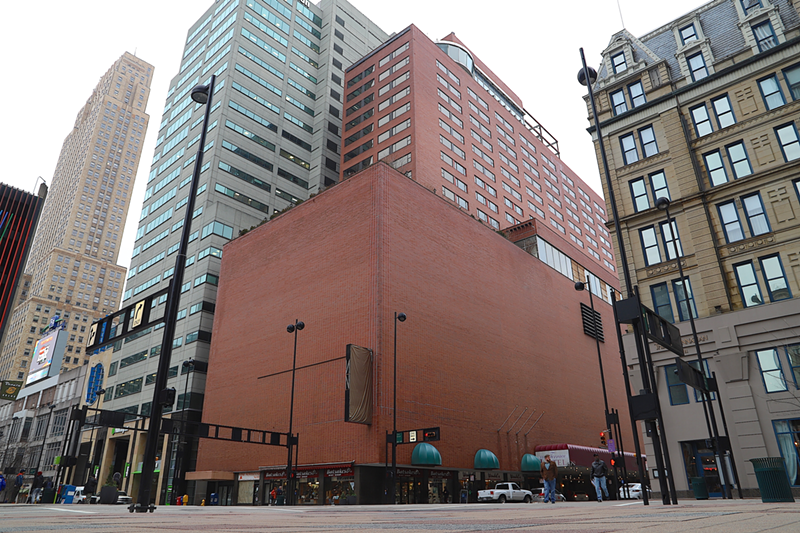Cincinnati City Council member David Mann has filed an application with the city's Historic Conservation Board seeking to make downtown's Terrace Plaza Hotel a local historic landmark, a move that could provide more protections as developers eye redevelopment of the Modernist building.
The proposal comes as at least one developer eyes big changes for the building, the ownership of which is currently caught up in legal limbo.
Constructed in 1948, the Plaza was the first International Style hotel to be built in the United States and was one of the first hotel construction projects launched after World War II. Its prominent place at 15 W. Sixth St. downtown and its innovative interior and exterior design belied Cincinnati's conservative reputation at the time. Filled with Modernist art, futuristic features like push-button elevators, a television in every room, guest-operated climate control and a distinctive eighth-floor terrace supported by a block-long, windowless facade that housed department stores, the building was a premonition of the coming sleek aesthetics of the 1950s and beyond. What's more, the majority of the design work was completed by a 24-year-old female architect named Natalie de Blois, who launched her career working for Skidmore, Owings & Merrill, now a major architectural firm, on its first hotel project.
But the 20-story structure has been largely vacant for more than a decade, save ground-floor retailers like Batsakes Hat Shop. There are numerous structural and aesthetic fixes that need to be made — boarded-up windows need to be replaced, plants are growing from the structure, key operational components are missing from the building and more. Plus, the former hotel's future is tied up in litigation between two competing buyers.
Despite those challenges, Mann says the building should be kept intact because it is hugely significant to the story of Cincinnati.
"I think it's important that the Terrace Plaza be preserved as it is," he said at a news conference at the Cincinnati Art Museum in front of "Mural of Cincinnati," a Modernist mural by artist Saul Steinberg that once graced the hotel's restaurant. "As you research the history of this building and learn about what it meant to this community and architecturally to the world, it is an amazing story. This is the first post-World War II hotel like this. It came to have national significance. It had a wonderful female architect who began her career with this building. The Emery family made sure it was produced and constructed in a way that respected what we would expect in our community. They brought together artists and famous sculptors."
Mann has personal connections to the hotel. He says he learned about his first election win — by a slim 430-vote margin — at 4 a.m. after hours spent waiting for returns in a hotel room at the Terrace Plaza.
"I have memories of all these things at the Terrace Plaza," he said. "Dining at the Gourmet Room. Folks ice skating on the terrace. Haircuts in the basement and dining in the basement in the cafeteria."
Mann gave credit for the landmark effort to members of the American Institute of Architects, the Cincinnati Preservation Association, Heritage Ohio and other groups who have worked toward the listing.
"These historic buildings all tell a story," Cincinnati Preservation Association Executive Director Paul Muller said at the news conference. "That's one of the reasons they resonate with people so much. The Terrace Plaza tells a different story than Over-the-Rhine or Music Hall or Union Terminal. It tells a really important part of Cincinnati's history, which is our role in innovation. That's really something that happened in Cincinnati. People went to sleep thinking it was the end of World War II and woke up thinking they were in a George Jetson future. Everything was push-button, no elevator operators. There was modern art. This building really shook the world. The Terrace Plaza set a new standard for how the world could be shaped by Modernism, both in functionality and in the arts, and it's really important that it be preserved."
But there could be plenty of complications ahead for any effort to redevelop the building. A group called JNY Capital purchased the property in August, and another prospective buyer, Anderson Birkla, promptly filed a lawsuit against JNY and the building's former owners. That company had been working to purchase the building, going so far as to draw up plans for a $61 million, mixed-used redevelopment of the property. That plan, however, calls for stripping the Terrace Plaza's unique windowless brick facade — a move preservationists say would destroy the character of the building.
Birkla's lawsuit currently sits with the U.S. District Court for the Southern District of Ohio Judge Michael Barrett.
Representatives from Birkla have said that they understand the concerns about the building's historic integrity, but also say that the structure presents a towering redevelopment challenge and that it simply isn't feasible to rehab the Terrace Plaza with the current seven-story windowless brick facade. There aren't many tenants out there for that amount of space without windows, the firm says.
But historic preservationists disagree and say that Birkla's proposed changes could cause the building to lose its place on the National Register of Historic Places.
"An alteration as extreme as removing all the brick from a building like the Terrace Plaza would change the physical integrity of the building to such a great degree that it would, in my opinion, jeopardize the National Register listing,'' former Cincinnati Historic Conservation Board member Beth Sullebarger told The Cincinnati Enquirer last year.
Mann points out the building's second floor once had windows and says he's seen credible plans that would put parking on the other windowless floors.
There is also an economic case to be made for preserving the building, Muller says.
"If it isn't historic preservation, we immediately lose historic federal tax credits, which could cover 20 percent of the project costs, and the potential for Ohio tax credits, which are 25 percent," Muller says. "The argument that it's either economic development or preservation died a long time ago in Cincinnati. Preservation is economic development and we've proved it. The Terrace Plaza can do that again."






